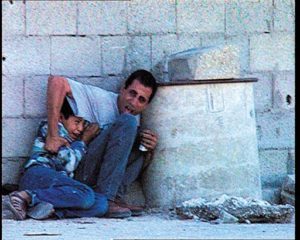 Mohammed Al-Dura was the twelve-year-old Palestinian boy shot and killed during an exchange of fire between Israeli soldiers and Palestinian demonstrators on September 30, 2000. The final few seconds of his life, when he crouched in terror behind his father, Jamal, and then slumped to the ground after bullets ripped through his torso, were captured by a television camera and broadcast around the world.
Mohammed Al-Dura was the twelve-year-old Palestinian boy shot and killed during an exchange of fire between Israeli soldiers and Palestinian demonstrators on September 30, 2000. The final few seconds of his life, when he crouched in terror behind his father, Jamal, and then slumped to the ground after bullets ripped through his torso, were captured by a television camera and broadcast around the world.
Source: Fallows, James. Atlantic Monthly, June 2003, “Who Shot Mohammed al Dura?”
A French judge ordered the release of video footage that could reopen the controversy surrounding the 2000 shooting of Mohammed al-Dura.
The appeals court judge in Paris ordered France 2 TV to show the court about 25 minutes of raw video footage shot on Sept. 30, 2000 at the Netzarim Junction in the Gaza Strip, when the 12-year-old Palestinian boy apparently was shot and killed in an exchange of gunfire between Israeli soldiers and Palestinian militants.
Al-Dura’s shooting death became an instant icon for Palestinian suffering at the hands of Israeli brutality, but the Israeli army, after initially apologizing for the death, concluded after an investigation that the boy could not possibly have been hit by Israeli bullets.
When Philippe Karsenty, director of the media watchdog group Media-Ratings, called France 2’s exclusive video of the incident “a hoax,” he was found guilty of slander. He appealed the decision, and on Wednesday the appeals judge ordered that the video be released. Karsenty called the court’s decision a victory. “This is only the first step in a victory,” his lawyer, Marc Levy, corrected him.
France 2, whose cameraman in Gaza, Talal Abu Rahma, shot the exclusive footage that was considered a major scoop at the time, was given until Nov. 14 to hand over the video to the court.
Several French and U.S. journalists who have seen the raw footage have indicated the shooting might have been staged by Palestinians.
A decision on Karsenty’s case is expected in February.
Source: Jewish Telegraphic Agency, September 19, 2007, “Al-Dura controversy deepens.”
It will be recalled that on September 30, 2000, France 2 ran 55 seconds of footage from the Netzarim junction filmed by its Gaza cameraman, Talal Abu Rahma. The footage showed Muhammad al-Dura and his father, Jamal al-Dura, crouching behind a barrel beneath a concrete wall. Shots were fired and Muhammad lay down in his father’s lap, and then moved his leg and arm. In his narration of the edited, blurry footage, Enderlin announced that the IDF had killed the boy. France 2 offered its edited video free of charge to anyone who wished to broadcast it.
In the days, weeks and months that followed, the al-Dura tape became the iconic image of the Palestinian war against Israel and, indeed, of the general global jihad against the West. It was invoked by the Palestinian mob in Ramallah that lynched IDF reservists Yosef Avrahami and Vadim Novesche on October 12, 2000. It was invoked by mobs of Israeli Arabs as they opened their violent riots on October 1, 2000.
THE IMAGE of al-Dura has been used in Hamas and Fatah terror recruitment videos, television shows and educational materials as a means to encourage Palestinian children to become suicide bombers. The al-Dura tape was used repeatedly in al-Qaida’s videotape of Wall Street Journal reporter Daniel Pearl’s execution in February 2002 and in other al-Qaida recruitment videos. His image was published in Iraqi Republican Guards newsletters and indoctrination materials before the 2003 US-led invasion. His name has been invoked repeatedly at Islamist and leftist anti-Israel demonstrations throughout the Western world.
Yet the IDF could not have killed the boy. An IDF investigation of the event in late 2000 showed that it was physically impossible for the IDF forces to have either seen or shot at the al-Duras from their position at the junction that day. Aside from that, independent investigations of the events of the day, carried out most notably by Prof. Richard Landes and shown at his Augean Stables Web site, and by Metula News Agency, showed that the event was likely staged. As investigators showed, throughout the day, Palestinian cameramen openly staged scenes of “carnage” performed by amateur Palestinian actors and Red Crescent ambulance drivers.
Source: Jerusalem Post, September 11, 2007, “A rotten state of affairs.”